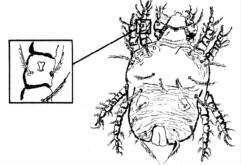 Cheyletiella spp mites Cheyletiella spp mites(Cheyletiellosis, Cheyletosis, "Walking Dandruff") This article is taken from the Boxer Parade Magazine, Summer 1979 Vol 2 Issue 1 Although 5 different species of Cheyletiella have been differentiated on the basis of minute morphological detail, the species most often referred to as C. parasitivorax (the rabbit fur mite). Cheyletiella spp have been reported from: rabbits, squirrels, birds, dogs, cats and man. Cheyletiella dermatitis is a mild, nonsuppurative mite-induced dermatitis produced by Cheyletiella spp. living on the surface of the skin. Significant Facts easily identified by 3 characteristics
Cheyletiella rasguri is the common species affecting dogs, while Cheyletiella prasitovorax is the species found on rabbits. Both species of mites can interchangeably transfer to man, dogs, cats and rabbits. It is not yet clear how long the mites survive on another host. Simple scurfy dandruff with pruritus in young puppies is highly suggestive of Cheyletiella dermatitis. Life Cycle
Behaviour Of The Mites
The mite is highly contagious, especially between puppies, but man may be affected too. Adult dogs are usually lightly infected even when in direct contact with infected puppies and very few mites or eggs can be demonstrated in debris from their coats. In contrast to dogs, cats have milder skin reactions and do not have severe cattery infestations, but may be a source of human infections (Gething, 1973). The mites do not burrow but live in the keratin layer of the epidermis and are not associated with hair follicles. They move about rapidly in pseudotunnels in dermal debris, but periodically attach firmly to the epidermis, pierce the skin with their styletlike chelicerae and become engorged with a clear colourless fluid (Foxx and Ewing, 1969). Clinical Signs
The course is chronic, affecting otherwise healthy individuals for many months. Infestation is most severe and generalized in two to eight week old puppies. Older individuals may be almost symptomless carriers. On puppies it is usually found in the rump region. Infestation spreads over the back and head but eventually much of the body is affected. Cats tend to have milder, more diffuse lesions and are remarkably free of pruritus. The cat's daily licking and washing probably remove many mites. Affected animals have excessively scurfy, slightly oily coats. The white (or yellowish) mites and eggs together with the keratin scales produced by the epidermal reaction produce an appearance of severe "dandruff'. Except for the scaling there is remarkably little skin reaction per se. Diagnosis
Other mite infestations (Otodectes cynotis, Sarcoptes scabiei, Notoedres catti, Dermanyssus gallinae and Eutrombicula alfreddugesi) can be differentiated by microscopic inspection of the mites. TreatmentSince all available references indicate success with a variety of insecticide treatments it appears as if the mite is highly susceptible to many chemicals. Removal of the mites has been reported with the topical use of Led-O-Sen, sulphur, benzyl benzoate·lindone solutions, and organo phosphate dips.Thorough treatment of all animals on the premises is necessary. Malathion, ronnel, lindane or carbaryl will be effective for dogs Pyrethrins, rotenone powder or limi-sulfur dips may be used safely on cats or rabbits. Treatment should be repeated three times at weekly intervals. Although mites do not live very long off the host, a strong effort should be made to physically clean the premises, improve sanitation practices and spray the area thoroughly at least once with a good residual insecticide. Promising results in control have been obtained by hanging appropriate numbers of dichlorvos fly strips in the general kennel area of pet shops with severe infestations. All new animals should be carefully inspected and dusted or sprayed with an insecticide before being added to colony housed animal facilities. Cheyletiella sp infection in man
Human infestations vary in severity, but after direct contact with infested animals, grouped, erythematous macules form on the trunk and buttocks. These rapidly develop a central papule which becomes vesicular and then pustular, finally rupturing to produce a yellow crusted lesion which is frequently excoriated because of the intense pruritus. Although the lesions are severely inflamed, they are well demarcated from surrounding skin. Older lesions have an area of cental necrosis which is highly diagnostic. Constant animal contact is usually needed to maintain human infections. With no further infestation lesions subside in three weeks. ReferencesCarroll, H. F.: Cheyletiella dermatitis. In Kirk, R. W. (ed.): Current Veterinary Therapy V. W. B. SaundersCompany, Philadelphia, 1974. Soulsby, E. I. L.: Helminths, Arthropods and Protozoa of Domesticated Animals. The Williams 6. Wilkins Company, Baltimore, 1968. |